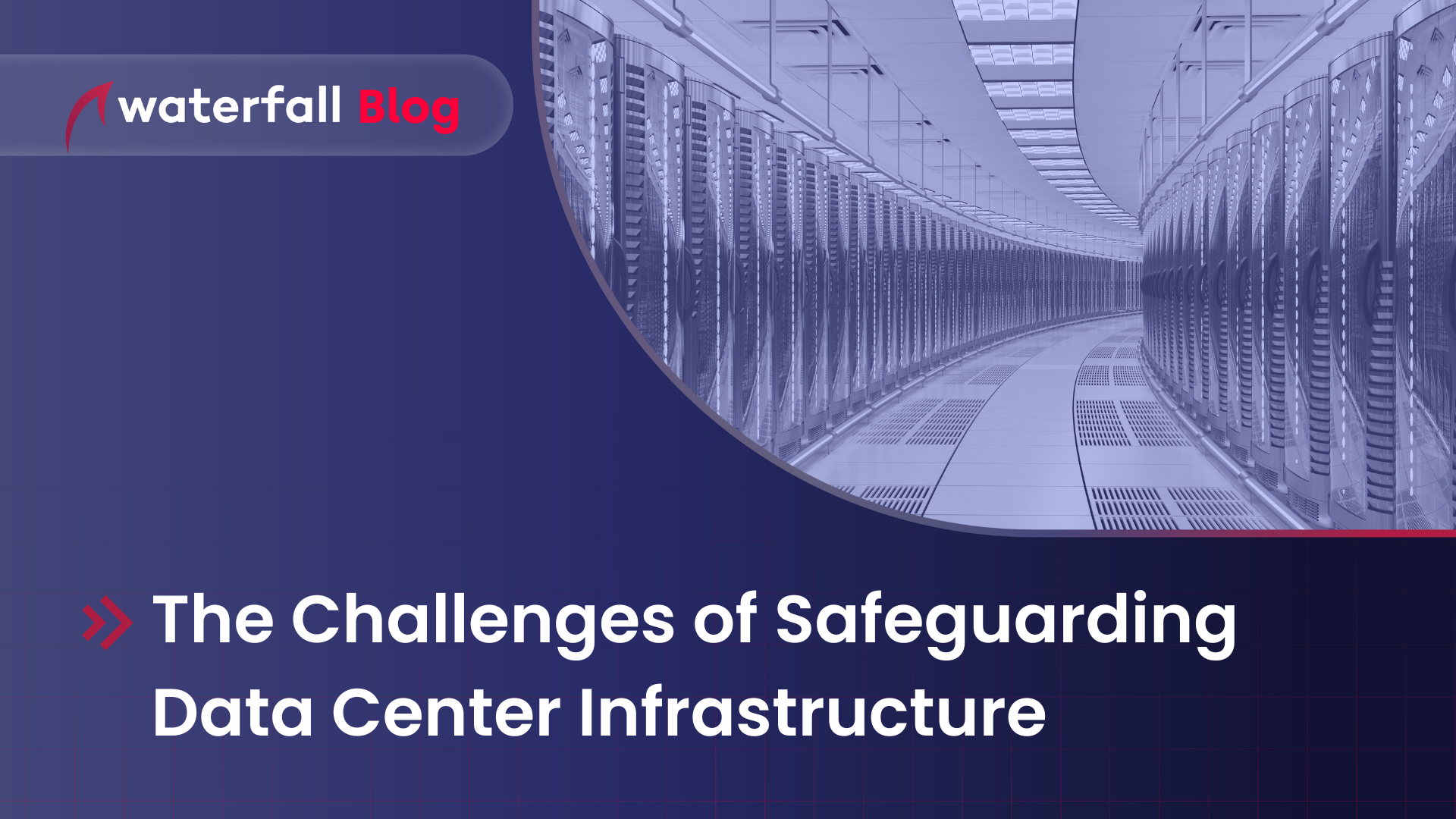The Challenges of Safeguarding Data Center Infrastructure
In today's technology-driven world, data centers serve as the lifeblood for countless industries by housing and processing vast amounts of information. As data centers grow in scale and complexity, so do the security challenges they face. Among the various security aspects, the threat to Operational Technology (OT) and Industrial Control Systems (ICS) have emerged as a real concern. In this blog post, we’ll shed some light on the significance of industrial security for data centers infrastructure and highlight the key measures to ensure protection.
Waterfall team

Understanding OT and ICS in Data Centers
Operational Technology (OT) refers to the hardware and software systems that monitor and control physical devices and processes that support data center operations. This includes supervisory control and data acquisition (SCADA) systems, building automation systems, power management systems, and other industrial-type controls. Industrial Control Systems (ICS), a subset of OT, manage and automate industrial processes, in data centers as in other industries, enabling seamless coordination between various components.
In data centers, ICS play a crucial role in managing cooling, power distribution, access control, and physical security. By optimizing these critical processes, data centers can maintain high availability, efficient energy usage, and optimal performance. However, this convergence of OT and ICS with traditional IT systems also introduces potential vulnerabilities that malicious actors can exploit.
…as data centers grow in scale and complexity, so do the security challenges they face.
Challenges in OT and ICS Security
Legacy Systems: Many data centers still rely on legacy OT and ICS systems that were designed without strong cybersecurity in mind. These systems might lack encryption, authentication protocols, or even security updates, making them susceptible to cyber threats. Replacing these systems, however, can be costly and difficult. Replacing these systems may reduce some cybersecurity issues, but any such upgrade involves large investments in engineering analysis and testing of the new systems to minimize the risk of forced downtime due to unexpected errors or operation of control systems post-upgrade – problems that put data center uptime at risk.
Interconnectivity: The seamless integration between OT, ICS, and IT systems improves efficiency but also expands the attack surface. Any breach in one system could potentially spread to others, leading to problematic consequences that can lead to downtime.
Insider Threats: Insider threats, whether intentional attacks or unintentional errors and omissions, can compromise data center security and trigger unplanned shut-downs of physical infrastructure.
Growing Complexity: Modern data center infrastructure, designed for efficiency, uptime and minimal environmental impact, coupled with the constant deployment of new technologies, makes it challenging to maintain a comprehensive understanding of potential attack paths.
Attractive Target for Cyber Attacks: Data centers represent high-value targets for cyber criminals and hacktivists due to both the sensitive information data centers store and the potential for disrupting financial, commercial and other essential operations in a society on a large scale.
Key Strategies for OT and ICS Security in Data Centers
Understand your OT Risks: Conducting regular risk assessments to enable understanding of which physical infrastructure is critical, is an essential part of identifying potential weaknesses in OT and ICS systems. This helps prioritize security measures and allocate resources effectively. Many issues can be prevented once someone is aware of them, and OT security is no exception.
Network Segmentation: Implementing strict network segmentation between industrial OT, and IT systems limits the threat of lateral movement in case of a breach. This ensures that compromising one system doesn’t lead to the entire data center being compromised. This also helps ensure that if one system is indeed compromised, it does not require a precautionary shutdown of all the other systems.
Secure Access Controls: Enforcing strong software access controls such as multi-factor authentication, least privilege principles, and role-based access to limit unauthorized access to critical systems helps to a degree, but sophisticated attackers routinely bypass such measures. Unidirectional gateways deployed at the IT/OT interface/connection are impenetrable to cyber attacks originating on IT networks or the Internet, even for sophisticated attacks.
Updates and Patches: Within IT, we upgrade and patch systems regularly and routinely. If an update proves problematic, we back it out. With OT, patch management is more difficult. As we explored in-depth in our Industrial Security Podcast episode 109, updating industrial controls systems can cause many side-effects, some of which are as serious as the cyber attacks the patches are intended to deflect – in a sense, “the cure is as bad as the disease.” While keeping all OT and ICS systems up-to-date with the latest security patches and firmware upgrades reduces the risk of exploiting known vulnerabilities, it can create immediate issues that include downtime, and that is never an acceptable side effect for any solution.
At the heart of modern technological infrastructure, data centers naturally prioritize OT and ICS security to safeguard critical operations and sensitive data. By understanding the unique challenges and implementing proactive security measures, data center operators can ensure the highest levels of protection against evolving cyber threats. A determined approach that includes risk assessment, network segmentation, access controls, and employee awareness will fortify data center infrastructure against potential breaches, enabling a safer digital future.
Want to learn how Waterfall Security helps protect data center OT?
Read our case study Cybersecurity for Data Centers with a real-world example of a data center in the Asian-Pacific region.
Share
About the author
Waterfall team
Trending posts
The Singapore OT Cybersecurity Masterplan
AI Takes on Polymorphic Malware | Episode 130
IT Remote Access VS. OT Remote Access
Stay up to date
Subscribe to our blog and receive insights straight to your inbox